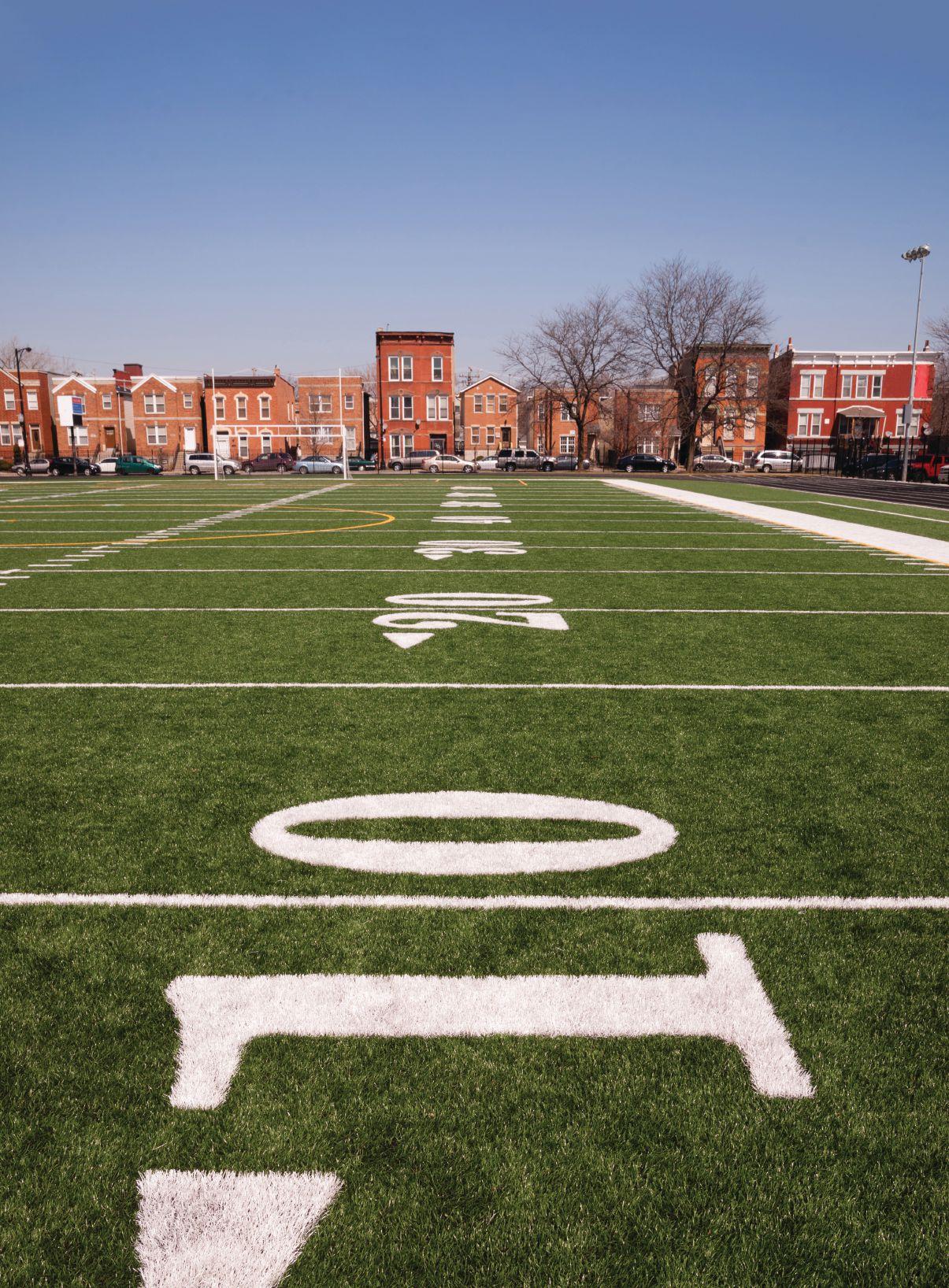

ARTIFICIAL TURF MAINTENANCE
Reliability that counts


DO MORE IN LESS TIME.
The impressive BR 600 is our number one selling backpack blower across the country…and for incredible reasons. It delivers a powerful performance with a strong air throughput for demanding cleaning tasks. Cleaning walkways, parking lots, stadiums, lawns and parks of leaves and debris will be completed efficiently and quickly. STIHL’s innovative 4-MIX™ engine provides outstanding performance, fewer emissions, more power and less fuel consumption. Its simplified starting procedure provides maximum productivity, its ergonomically designed to reduce vibrations and increases comfort with the dual-adjustable shoulder strap and easy-grip throttle with cruise control. The BR 600 has everything a PRO needs!
SPECIFICATIONS
① Weight without fuel. ② With tube at nozzle end.
PRO-FLEET COMMERCIAL LANDSCAPE PROGRAM
STIHL’s Pro-Fleet Commercial Landscape Program is designed to provide commercial landscapers a volume discount on major purchases of five or more landscaping power tools. Visit your STIHL Dealer today to find out more and take advantage of the savings!



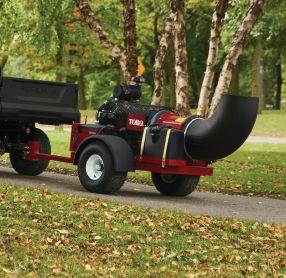
DEPARTMENTS

By Mike Jiggens
The evolution of artificial turf fields
Our cover story this issue takes another look at artificial turf maintenance, yet from a somewhat different perspective from a similar story on the subject we published in our June/July issue.
That story was focused more on the upkeep of the surface itself. In this issue’s story, what lies beneath and how to care for the infill forms the basis of this next chapter in synthetic sports turf maintenance practices.
The message was presented during this year’s Ontario Turfgrass Symposium’s virtually delivered event. Speaking on the subject was University of Guelph facility supervisor Cam Lawrie, who looks after a number of artificial playing surfaces on campus.
Like it or not, artificial turf is here to stay. What was once commonly known as “AstroTurf,” the synthetic “carpet” has come a long way since it first garnered attention as the playing surface inside Houston’s Astrodome, where it was impossible to grow natural turf. The fabled Astrodome became the world’s first domed stadium to serve as a multi-purpose venue for professional sports. It was the home field for Major League Baseball’s Astros and the National Football League’s Oilers.
The turf wasn’t much more than a green-coloured carpet in the beginning. It bore a passable resemblance to natural turf
when viewed on television, but seen and felt up close told a different story. The resemblance to the real thing wasn’t even close.
Fast forward 50-plus years. Artificial turf – no longer referred to as AstroTurf, except among those still clinging to the past – certainly looks a lot more like natural turf than it did at the outset, and its feel is much closer as well.
But, ask a selection of municipal sports turf managers about their preference – natural or artificial – and you’ll find more of them are beginning to embrace the synthetic option. Compelling arguments will be made in support of both types of playing surfaces.
More and more artificial fields have been popping up on
Compelling arguments will be made in support of both types of playing surfaces
the landscape in recent years, especially among high schools. A slew of Ontario secondary schools have installed artificial turf fields over the past half-decade for use by their football, soccer, rugby and field hockey teams, not to mention by other community groups in some cases.
Proponents of artificial turf fields will acknowledge the huge expense of their installations, but will argue savings will be realized without the need for such inputs as fertilizer and approved pest control products.

On the other side of the coin, natural turf advocates will argue the projected lifespan of an artificial turf field doesn’t justify the expense of its installation.
The athletes themselves are perhaps the ones whose opinions matter most. A football player is apt to say he’d rather be tackled on natural turf. A baseball player may say he’d rather make a diving outfield catch on natural turf to minimize the abrasion to his exposed skin. A soccer player might prefer playing on a natural surface on a 30-degree Celsius day.
Still, there are some athletes who are drawn to artificial turf fields, especially following a major rain event when the odds of a game being cancelled are minimized.
Love it or loathe it, one thing that can be said about artificial turf is that it’s evolved exponentially over its earlier generations. It’s more like grass and less like carpet. Its behavioural characteristics are inching closer to natural turf in terms of its playability and safety.
The technology behind artificial turf is constantly improving. Once its lifespan is able to double without the same happening to its cost, artificial turf sports fields will be embraced by more and more municipalities.
One of the key components to an artificial turf field is its infill. Crumb rubber made from old tires was once the standard, but it’s giving way to more environmentally friendly options, including thermal plastics and organic materials.
It appears there’s room on this planet for both natural and artificial turf fields.
www.turfandrec.com
Reader Service
Print and digital subscription inquiries or changes, please contact
Anita Madden, Audience Development Manager
Tel: (416) 510-5183 Fax: (416) 510-6875
email: amadden@annexbusinessmedia.com
Mail: 111 Gordon Baker Rd., Suite 400 Toronto, ON M2H 3R1
Editor Mike Jiggens mjiggens@annexbusinessmedia.com
National Advertising Manager Rebecca Lewis 519-400-0322 rlewis@annexbusinessmedia.com
Nashelle Barsky 905-431-8892 nbarsky@annexbusinessmedia.com
Account Coordinator Mary Burnie 519-429-5175 mburnie@annexbusinessmedia.com
Group Publisher Todd Humber thumber@annexbusinessmedia.com
COO Scott Jamieson sjamieson@annexbusinessmedia.com
Printed in Canada ISSN 1186-0170
PUBLICATION MAIL AGREEMENT #40065710
SUBSCRIPTION RATES
Published 7 times a year – Jan/Feb, March, Apr/May, June/July, Aug/Sept, October, Nov/Dec
Canada – 1 year $35.00; 2 year $45.00 3 years $55.50 (plus applicable taxes HST 86717 2652 RT0001
Occasionally, Turf and Recreation will mail information on behalf of industry related groups whose products and services we believe may be of interest to you. If you prefer not to receive this information, please contact our circulation department in any of the four ways listed above.
Annex Privacy Office privacy@annexbusinessmedia.com Tel: 800.668.2374
No part of the editorial content of this publication may be reprinted without the publisher’s written permission © 2021 Annex Business Media. All rights reserved. Opinions expressed in this magazine are not necessarily those of the editor or the publisher. No liability is assumed for errors or omissions.
All advertising is subject to the publisher’s approval. Such approval does not imply any endorsement of the products or services advertised. Publisher reserves the right to refuse advertising that does not meet the standards of the publication.

WHO SAYS YOU CAN’T FIT A SMARTGRADE™ DOZER INTO SMALL SPACES? WE FIT ONE INTO A CTL.


THE 333G SMARTGRADE IS HERE. THE WORLD’S FIRST COMPACT TRACK LOADER WITH INTEGRATED 3D GRADE CONTROL. It’s the brain of a SmartGrade dozer inside the nimble body of a CTL. So you can now precision grade in tight spots crawlers can’t reach. The 333G automatically controls the custom-engineered six-way blade, helping both new and experienced operators finish faster. It also helps operators learn faster thanks to the exclusive DozerMode control solution, enabling the electrohydraulic (EH) joysticks to function like a crawler. Precision. Speed. Versatility. It all just fits.
JohnDeere.ca/SmartGradeCTL *Shown with
Stanley Black & Decker acquires Excel Industries
Stanley Black & Decker is acquiring Excel Industries for $375 million in cash. Excel designs and manufactures commercial and residential turf care equipment, including such brands as Hustler (Hustler Turf Equipment) and BigDog (BigDog Mower Co.). Excel serves about 1,400 independent equipment dealers in Canada and the United States. Stanley Black & Decker is a $14.5-billion global diversified industrial with 56,000 employees in more than 60 countries.
Artificial turf project in Calgary getting rave reviews by officials
Officials are praising the virtues of a new $6-million artificial turf project that has opened at Calgary’s Genesis Centre. The field, which began construction in April, replaced a natural turf field at the south end of the centre. Sherry King, executive director of the Genesis Centre, said it had poured rain just prior to the field’s opening, noting the field was completely dry within a half-hour afterward. Funding of the project came from the centre itself as well as from the city and the Alberta government.
CGSA among groups thanking golf’s superintendents
International “Thank a Superintendent Day” was marked in September in the golf world. The Canadian Golf Superintendents Association (CGSA) commemorated the special day, encouraging those who enjoy golf to thank their golf course’s superintendent. The official day was originally recognized in 2020.
The CGSA was joined by other international superintendents associations in marking the occasion.
Groundskeeper caring for field that’s seen no play since 2019
Heading into the 2020 baseball season, Ross Baron, head groundskeeper at Vancouver’s Nat Bailey Stadium, had been named sports turf manager of the year for a third straight year in the then minor Northwest League. But COVID-19 cancelled league play altogether in 2020 and forced the Vancouver Canadians to start the 2021 season in Oregon to comply with border-crossing restrictions.

While other employees were able to work from home during the pandemic, when possible, Baron was on site to maintain pristine playing conditions and typically found himself to be the lone individual on the premises.
The team was hopeful it could return to Vancouver at some point this season, but it was not to be. That has left Baron caring for a field that hasn’t seen any play since 2019.
The Canadians, a minor league affiliate of the Toronto Blue Jays, began the 2021 season in Hillsboro, Ore. with hopes that COVID-related border restrictions would sufficiently loosen in time to finish the season at their home park.
For Baron, it means two consecutive seasons of maintaining a ball park that has seen no play. The graduate of the University of Guelph’s turfgrass management program was named among Turf & Rec’s Top 10 Under 40 honourees a couple of years ago.
The last home game the Canadians played at Nat Bailey Stadium was in August of 2019. Baron was on standby throughout the current summer, wondering if word would be given for play to return to Canada. It meant having to have the field ready to go at a moment’s notice.
Baron, a native of Gibsons, B.C., got his first taste of working at a professional baseball stadium in 2012. He interned with the Washington Nationals of Major League Baseball’s National League before becoming a sports turf manager with the City of Kelowna for three years.
The field at Nat Bailey Stadium was in tiptop condition when the Canadians were told they’d remain in Hillsboro to finish the current campaign. Baron said he had hoped to put his work on display, but that may not happen until 2022.
Efforts were made by the Canadians to seek a quarantine exemption from the federal government that would allow cross-border travel, but an arrangement was never made.
Other Vancouver sports teams, including soccer’s Whitecaps and football’s Lions, were granted such arrangements.
In recent years, the Vancouver Canadians have moved up in the baseball world, from a team playing short-season, Single-A baseball over a 76-game season, to the High-A West League which plays a 120-game regular season schedule.
By Turf & Rec
National GC’s Dew is 2021 super of year
Chris Dew, superintendent at The National Golf Club of Canada in Woodbridge, Ont., has been named superintendent of the year for 2021 by the Canadian Golf Superintendents Association (CGSA) and Bayer Environmental Science Canada.
The award recognizes a member of the CGSA who has held the position of golf course superintendent for a minimum of five years and who has distinguished him or herself through dedication to the profession, performance as a golf course superintendent and contributions to the profession and community.
“Chris has set the bar high for all superintendents in Canada,” CGSA president John C. Scott said. “He manages one of the top courses in the country and provides superior playing conditions on a consistent basis. He does this year after year and yet remains a humble, kind, patient, and true friend to so many in the industry.”
Colin White, marketing manager for Bayer Environmental Science Canada, the award’s sponsor, also praised Dew for his achievement.
“Whether it’s providing first-class playing conditions at The National or mentoring the many assistants and AITs that have worked under his direction, Chris has much to be proud of,” White said. “Chris is known for his professionalism and his willingness to help others in the turfgrass profession, and this award recognizes those efforts.”
Dew said it was “an absolute thrill” to have received the news of his selection.
“It certainly has been a wonderful lifelong journey, throughout which I am gratified to have developed bonds with countless industry peers and blessed to have several become true friends,” he said.


Industry experience
“Chris has set the bar high for all superintendents in Canada”
Dew has been a CGSA member since 1995 and has held the accredited golf superintendent (AGS) designation since 2007. He has been the superintendent at The National Golf Club since 1997. The course has been ranked several times among the best conditioned golf courses in Canada. He was an active member of the Ontario Turfgrass Research Foundation board and responsible with fundraising for turf research. Additionally, he was an instructor at the John Deere/Bayer Green Start Academy, helping assistant superintendents develop their business and leadership skills, and has participated in focus groups that have forwarded information for CGSA initiatives and further programs. He values the importance of having national and provincial associations that can best represent golf course turf managers and has mentored numerous students and assistants – many of whom have moved into superintendent positions.
His early work experience started in the 1980s at the Weston Golf Course as the assistant superintendent. He moved to Royal Woodbine as superintendent in 1990 before moving into the same role at The National Golf Club of Canada in 1997.
“Chris has provided his membership with potentially unparalleled
playing conditions throughout his career,” Ontario Golf Superintendents Association president Al Schwemler said. “The challenge of satisfying a demanding membership consistently in this day and age is extremely difficult. His patience, perseverance, and uncanny ability to navigate a diverse and dynamic occupation has allowed Chris to succeed. Molding a team of professionals to see and execute his vision has been paramount to his success and weathering Mother Nature’s many storms.”
Dew will be formally recognized during the Canadian Golf Course Management Conference and presented with his award during the award luncheon in 2022.
As the CGSA/Bayer superintendent-of-the-year winner, he will receive:
• Attendance at and participation in the 2021 Fall Field Day
• An “all-access” registration to The Canadian Golf Course Management Conference for himself and a companion
• A site visit with a written agronomic report from a Bayer green solution specialist
• A $5,000 Bayer plant protection package for the golf course
• A trip for two to attend a Bayer educational opportunity that would include golf
Chris Dew has been the superintendent at the National Golf Club of Canada since 1997, and has performed a number of roles within the industry over the years.
GGSA photo

Walk the field: the key to maintaining artificial turf fields
Looking, listening and feeling can detect small problems before they become big ones.
By Mike Jiggens
Artificial – or synthetic –turf has been in existence for more than half a century, and has gone through a succession of generations over the years – each a notable improvement over the previous version.
It has been the playing surface of choice for several professional teams in such sports as football, baseball and soccer. Municipalities have been enticed by the allure of artificial turf sports fields for various reasons. Although many of these cities and towns prefer natural turf playing surfaces, having an artificial field on hand gives their worn natural fields a chance to recuperate for a week or two without depriving user groups of a place to play.
Many municipalities also like being able to schedule games on a field that is ready to go immediately following a rain event.
One of the fallacies associated with artificial turf, however, is that it’s maintenance-free. In fact, it requires regular main-
tenance just like its natural counterpart. It’s only the type of maintenance that differs.
Manufacturers of artificial turf note that a field’s lifespan is generally between five and eight years. But, regular daily maintenance can extend the life of a synthetic field significantly longer.
Cam Lawrie, facility supervisor for the University of Guelph’s Alumni Stadium, Gryphon Fieldhouse and other outdoor fields, spoke of the importance of artificial turf maintenance last winter during the virtually-presented Ontario Turfgrass Symposium.
The oldest of the university’s artificial fields entered its 12th operational season in 2021, proving that regular maintenance can breathe new life into synthetic fields.
“It’s quite a departure from the recommended lifespan,” he said.
The university has developed a robust system of maintenance for its artificial fields with a program aimed at keeping safety levels and playable conditions to a
degree on par with when the system was originally installed.
“Most of the things we had that have required repair were preventable if we had paid a little more attention to our regular routine maintenance.”
Lawrie said proper field maintenance is beneficial culturally, economically and environmentally. User groups that find the field’s surfaces safe to play on will trigger an economic benefit, he said.
“It will bring more revenue to your facility, to your municipality, and it will bring others as people tell their colleagues and friends about the great facilities they have, and it will also reduce the economic cost of replacing a field as well.”
Revenue is generated as a result of a well-maintained artificial field, and money is saved by not having to replace the field as readily. Additionally, the sports field manager has become a good steward of the environment by not having to send large quantities of material to a landfill.
Regular walks about an artificial turf sports field can help extend the life of a synthetic surface beyond the manufacturer’s projection.
THE GAME HAS NOW CHANGED

This is the season of recreation, outdoor pursuits and renewed focus on fine turf surfaces. Turf Fuel’s innovative new Vertical will surely give you a fresh edge and ensure a successful growing season.
VERTICAL™ FUEL FOR BOTH PLANT & SOIL NEW
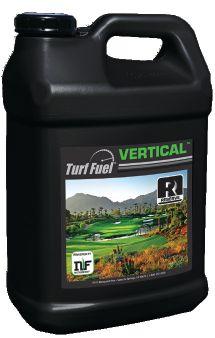
ABOVE GROUND: Anti-stress technology
• Wellness triggers
• Super efficient potassium
• Antioxidants
Growth promotion
• Improved photosynthesis
BELOW GROUND: Rooting technology
• Food for soil microbiology
• Proprietary three part organic acid blend
Improved nutrient availability
• Key sugars for plant health and microbial stimulation
• Rich carbon supply for rhizosphere
target-specialty.ca |
Mitch Davidson
Southern Alberta, Kootenays mitch.davidson@target-specialty.com 587.223.2083
Jason Hooper
Lower Mainland & Interior Bc jason.hooper@target-specialty.com 604.317.2476
Chris Paterson
Southern Alberta & Kootenays chris.paterson@target-specialty.com 403.540.0157
Eric Gratopp
Northern Alberta eric.gratopp@target-specialty.com 587.284.4744
Gregor Kowalski
Vancouver Island gregor.kowalski@target-specialty.com 250.686.3909
Josh Seibel Saskatchewan & Manitoba josh.seibe@target-specialty.com 306.861.8296
Mark Scenna Sales Manager, Canada mark.scenna@target-specialty.com • 416.458.2396
Perry Brazeau Toronto / East perry.brazeau@target-specialty.com 416.705.8006
Colin Hindle
Ottawa & Eastern Ontario colin.hindle@target-specialty.com 613.314.9711
Jason MacRae
Quebec North & West jason. macrae@target-specialty.com 514.712.8006
Mitch Guy Northern Ontario mitch.guy@target-specialty.com 705.444.9010
Joey Losito
Quebec South & East joseph.losito@target-specialty.com
819.571.1677
Craig McCutcheon
South-West Ontario craig.mccutcheon@target-specialty.com 905.351.6544
Chris Nelson
Toronto West / Niagara chris.nelson@target-specialty.com • 647.382.6868
Walking the field
The key to a good maintenance program is having staff who are well-trained and knowledgeable, Lawrie said. The first and perhaps most important step toward a solid maintenance program is to walk a field and look for signs of pending problems so that they can be addressed before they turn into safety and playability issues.
He noted a soccer field on campus had developed a small hole in the back of the turf adjacent to a penalty kick dot. Although the field was already eight years old at the time, the hole was preventable and was largely due to a lack of maintenance and observation. The fix, he said, would have involved taking a few seconds to walk over the spot and feel a divot forming in the field’s infill system. About 30 seconds of sweeping to redistribute and relevel the infill material could have prevented the hole from developing, he said.
Lawrie recalled another preventable setback that happened at the university’s varsity field in which a penalty dot area had detached from the seaming paper that held it in place amid the turf around it. The detachment was upwards of two inches in size and, although the turf was aging, “overall, a lack of maintenance and a lack of observation led to a situation where the fibres in the turf were unsupported by the infill system in it, and we saw some damage result from it.”
That problem, too, could have been identified by means of a field walkabout and taking the short time needed to sweep the infill. The expense of time and labour involved would have been minimal, he said.
One of the more peculiar setbacks occurred to a campus football field in 2020 during the COVID-19 spring lockdown. A squirrel had allegedly tried to bury a walnut into a section of the field at the 15-yard line, approximately midway between the hash marks and numbers. Before long, a new walnut tree began to grow with a developed root system and branches. Lawrie said if someone had walked the field, the walnut could have been spotted and removed before it caused any damage.
Weeds can be detected during field walks and pulled before they create bigger problems, he added.
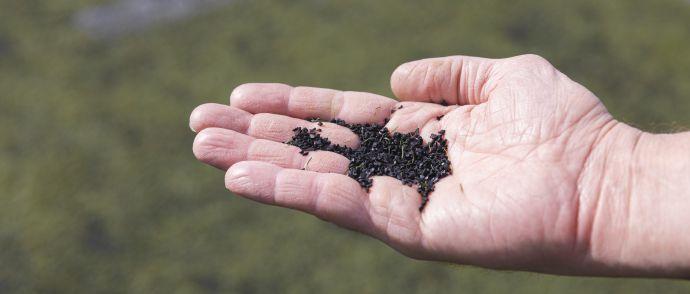
“The techniques that could have remediated those problems were simple and didn’t require any extensive machinery or knowledge, but were ignored long enough that they created a bigger problem. A repair is never as good as the original installation.”
To repair the hole found in the penalty dot area of the soccer field, a square of turf from the field’s edge was cut out as a patch, but it didn’t look the same and it compromised the field’s playability.
Infill system types
Lawrie said there are two types of infill in artificial turf systems – stabilization infill and function infill. The stabilization infill stands up and supports the turf fibres. Function infill gives the field its cushioning and feel. Infill had traditionally been made from recycled tire crumb rubber, but technology has since ushered in thermal plastics and other materials designed for shock absorbency. With the industry turning toward more environmentally friendly solutions, several manufacturers have opted for organic infill products.
Typically, the proportion of infill is about two-fifths of stabilization material to three-fifths of function material, “and the depth and the proportions of those is crucial to how it functions.”
Lawrie said that in areas of high traffic and wear, the proportion may shift to three-fifths stabilization and two-fifths function in order to properly support the fibres that are experiencing high stress and strain during game play.
Fibre projection is the amount of turf
that extends above the infill system, and is about 18 to 20 millimetres for a straight-bladed product and 15 to 18 millimetres for a textured fibre. At the University of Guelph’s varsity field, the fibre length is about 42 millimetres in total, meaning there are only 22 to 24 millimetres of infill material to provide the necessary shock absorbency.
“That’s why it’s important that we maintain this infill system and why we pay close attention to it.”
Field walks and basic remediation are the “bread and butter” of a maintenance program, Lawrie said, adding they must be done on a day-to-day basis to properly maintain the turf, especially as it ages.
“Field walks are the real work of field maintenance. They’re so simple, it’s elementary.”
Field walks are a systematic inspection of a field’s surface, particularly in hightraffic areas including penalty corners, face-off dots, goal mouths, access points, bench areas, seams, in-laid lines, logos and numbers. The field should ideally be walked in five-yard passes and include both the playing area and its surrounds.
When walking a field, all foreign objects need to be picked up. Lawrie said among the items that have been picked up on his fields include Lego blocks, jewelry, athletic shoe spikes, and screws, nuts and bolts. Those assigned to walk fields should be looking for signs of trouble, he said. Early detection, especially in high-traffic areas, will allow 85 to 90 per cent of abnormalities to be remedied before they become larger problems.
On aging turf surfaces, unusual-looking
Tire crumb rubber was once the standard infill used in artificial turf sports fields, but a shift has been made to thermal plastic and organic materials.
lines and bunched-up seams are indicators of degradation. Divots in the infill can be detected by a difference in colour and texture of the turf, indicating a shift in infill material. Bare patches allowing the backing of the surface to be seen suggest fibres have been ripped out.
Lawrie said field walkers should rely on their feet to feel for divots and hard spots. By taking small steps back and forth and side to side over hot spots, “you’ll be able to feel divots very easily and you’ll be able to feel compacted infill very easily.”
Infill can be swept back into place to level out divots. Lawrie suggested taking a stiff-bristle broom and, while walking in a circular pattern, sweep in multiple directions. A soft-bristle broom can be used afterward to create a smooth finish. The process takes, on average, between 30 seconds and two minutes to accomplish.
“If the divot is extremely deep and goes right down to the stabilization layer of the infill, you might need to add some sand back in to protect the integrity of those fibres.”
If infill has become too compacted, a similar yet opposite approach is recommended. A soft rake should be used at the outset to help loosen up the infill while walking in a circle and raking in multiple directions. A stiffer rake can then be used immediately afterward. Lawrie said the process should take between two and 10 minutes to rake out a compacted area, depending on its size.
“Field walks are your best defence against problems that are going to become larger problems and require repairs.”
Keep a history log
By keeping a log of trouble spots found and repairs that have been made, maintenance programs can be modified as the turf gets older, he said.
With aging systems, adhesives start to fail, leading to seam separation. The edges and corners of the turf begin to fold up as a result. A temporary fix for a partial seam separation is to vacuum underneath it, allowing the turf to relax and settle back in place. A wet-dry vacuum works well, but needs to be emptied before use so that the collected infill material remains intact and can be replaced.
As the turf gets older and more trod upon, the infill becomes more compacted and the fibres get trampled and knocked over, requiring remediation. Causes of compaction include regular game play and practices, post-game celebrations and other events taking place on the field. Additionally, heavy equipment needed to pull groomers need to be on the field.
The long-term implications of widespread infill compaction include poor playability of the field with inconsistent ball roll and poor traction among athletes, monofilament fibre damage, increased costs due to early replacement of the field and disposal fees, and injuries and litigation.
Grooming of the field fights widespread infill compaction and maintains playability and safety. While grooming, Lawrie suggested equipment operators “look, listen and feel” for possible problems that might arise. They should look for ripples in the turf, listen for changes in engine rpm and feel for “jackrabbiting” of equipment and the pulling of implements to either side.


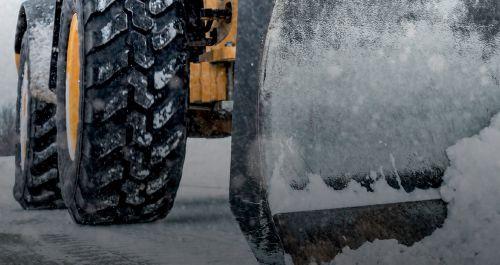

When winter gets here, you’ll be ready for it with the John Deere 244L and 324L compact wheel loaders from Brandt.
More Productivity
More Availability
More Support

Pesticide cutbacks & quality upkeep
How a GTA golf superintendent reduced his pesticide inputs without compromising the quality and conditioning of his golf course
By Mike Jiggens
Golf courses in Ontario were given a wake-up call a little more than a dozen years ago when the provincial government decided it wanted to clamp down on chemical pesticide use on turfgrass. In 2009, the Ontario cosmetic pesticide ban was enacted, and golf courses were originally going to have to comply with the same legislation that has long since impacted the lawn care and sports turf industry sectors.
Golf fought hard to be granted an exemption to the ban, but it came with the stipulation that several requirements were necessary in order for courses to continue to use certain products. At the very least, it motivated golf superintendents toward adopting strategies that were more environmentally friendly.
Some clubs went the extra mile, cutting back their pesticide usage considerably. This achieved two purposes – it left a healthier footprint on the golf course and freed up budget money that could be utilized elsewhere.
The Thornhill Golf Club in the Greater Toronto Area was one such facility that went down a new path in 2009. Approached by Global Organics Partners
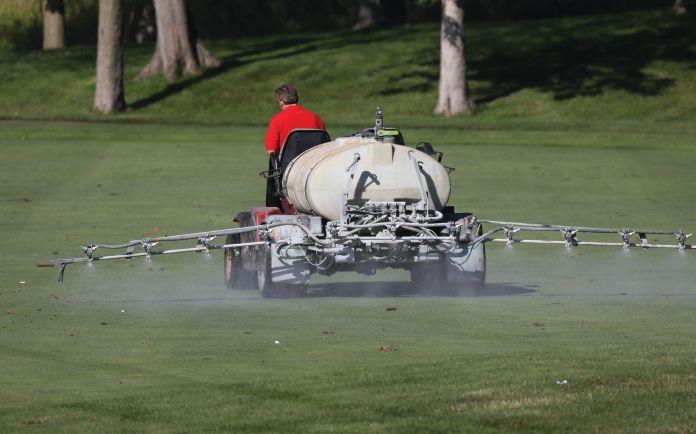
(GOP) – a group of academic researchers – the club was told how it could significantly reduce its pesticide use without compromising the quality or conditioning of the golf course.
Greg McFarlane, superintendent at Thornhill for the past 14 years, shared his strategy of substantially decreasing his pesticide usage over the years in a virtual presentation offered during the winter’s Ontario Turfgrass Symposium.
“One thing that was made clear was that they (GOP) wanted to do this without impacting the quality or conditioning of the golf course, which I found very intriguing,” McFarlane said.
At the time the Ontario government was planning its ban on cosmetic pesticide use, McFarlane said he feared a mandated discontinuation of products he had been accustomed to using for years, but he felt GOP’s proposal was something worth trying. Thornhill’s board of directors and club committees were also on board with it.
The relationship between Thornhill and
GOP began in 2008 and remains intact today. The researchers, who are mainly academics from U.S. institutions, are not only experienced in diseases, insects and weeds, but in all aspects of turfgrass management, including cultural practices, biological approaches and other areas of turf maintenance.
Up until 2020 – when the COVID-19 pandemic presented a roadblock – a researcher from the group visited the golf course and discussed various issues of concern to McFarlane, all the while sharing with him the latest research data.
“The visits give the researchers an opportunity to see the course and to observe the issues I’m dealing with at any given time throughout the season,” McFarlane said.
The meetings, which could be often in some years, helped McFarlane remain focused on his goals, including the reduction of pest control products while maintaining the highest possible golf course standards.
Topdressing, aeration, fertility and irrig-
Thornhill Country Club has dramatically cut back on its pesticide usage over the past several years.




















Industry Innovators
ation practices were looked at in the beginning as a means of reducing Thornhill’s chemical dependency. Although the club’s greens have demanded the most attention by GOP’s visiting researchers, sufficient attention is also given to fairways, tees, roughs and naturalized areas.
Century-old greens
Many of Thornhill’s putting surfaces are the original pushup greens built almost a century ago. The 18-hole championship course has one USGA-spec green while the adjacent nine-hole executive-length course has a combination of original and USGA greens.
“Uniformity isn’t there,” McFarlane said. “We have a mixed bag of soils. We have microclimates to deal with.”
When McFarlane began working at the Thornhill club as an assistant superintendent in 1995, the greens still had some bentgrass, but had become predominantly poa annua over the years. The golf course also had ample tree cover during his early years, but a significant amount of tree removal and pruning have since been done to maximize sunlight penetration.
GOP’s objective at the outset of its working relationship with Thornhill was to become better acquainted with McFarlane’s course management philosophy and to learn more about the specific issues he faced.
“During the last few years, we’ve started to see some improvement, following some of the recommendations we’ve been

given,” he said, adding GOP doesn’t sell pesticides, but will recommend certain products, rates and timing of applications in certain situations.
The goal has always been to reduce inputs without negatively affecting the quality of the golf course. For example, greens can’t be rendered too fast because it will lead to a slower pace of play, McFarlane said.
One of the key components of GOP’s contribution was the assignment of an environmental impact quotient (EIQ) to pesticide products. Developed at Cornell University and based on research of pesticide products, EIQ serves as a guide to see where reductions are being made. The higher the EIQ number assigned to a pest control product, the greater its impact on the environment.

The club adopted the EIQ system of measurements from 2011 to 2015, during which time the number dropped to 58 by 2015 from a starting point of 206 per hole.
“That’s a pretty significant drop.”
Steadily falling EIQ
Auditing firm KPMG looked at the EIQ numbers of Ontario’s top 100 golf courses, finding they averaged 1,100. Since 2015, the Thornhill club has remained steady at between 50 and 60 with the number dropping to a low of 37 in one year.
McFarlane said another way the club has measured its input reductions is via the number of pounds of active ingredient applied per hole. In 2015, the club put down six pounds of active ingredient per hole while other clubs in the area were averaging about 83 pounds per hole – about 93 per cent more than Thornhill’s use.
When Thornhill began working with GOP, McFarlane said he thought the club might have to spend more on biological inputs and labour to achieve its goal of pesticide reductions. In 2008, the club spent about $102,000 in pest control products. Costs dropped slightly the following year, but a significant decrease was realized in 2010.
The golf club was challenged that year when a major storm hit the area in late 2009. It began with heavy rain, but soon turned to freezing rain. As temperatures dropped, about two inches of solid ice formed across the entire golf course property.
“It was pretty ugly,” McFarlane recalled. “You could have skated from one end of the course to the other.”
With the turf yet to enter dormancy at the time the storm hit, McFarlane said he anticipated some serious issues by the time spring of 2010 arrived.
“We were dealing with dead turf all over – fairways, tees, greens, even rough areas.”
Thornhill’s relationship with GOP was at its most important in 2010, he said. The group of researchers recommended seed varieties and seeding strategies as well as specific fertility and irrigation practices.
“In the end, we came out of that spring in pretty good shape.”
The club made good inroads by introdu-
Thornhill’s greens have received the most attention from the Global Organics Partners researchers over the years, but tees, fairways and roughs have not been neglected.
cing bentgrass into its greens in 2010. Although some poa has since crept in, significant bent coverage remains.
Little spraying was required in 2010, allowing costs to drop to just below $73,000. Pest product expenditures from 2011 onward averaged between $96,000 and $97,000, but strides were being made toward reducing EIQ numbers.
Pesticide product purchases began to drop significantly in 2014. Slightly less than $58,000 was spent that year with another $4,000 reduction in 2015. A huge decrease was realized in 2016, at just under $32,000, while 2017 saw a slight rise to about $33,000. Since then, product expenses have averaged between $30,000 and $35,000 – or an annual savings in pest control products of about $70,000.
“Each year is different,” McFarlane said. “Pressures vary from year to year, and weather conditions can have an impact.”
Growing pains
McFarlane said there have been a number of “growing pains” along the way that have resulted in short-term green speed reductions and some brown turf – some of which he attributes to human error on his part due to questionable decision making. Thornhill’s irrigation system is also 25 years old now and may not be as efficient as it once was, he added.
“Not using pesticides has had nothing to do with any issues we’ve had on the golf course in that time.”
But, the ongoing program with GOP has allowed Thornhill to consistently emerge each spring in good shape.
With his budgets reduced during many of these years, McFarlane said the cost savings were a blessing. His input costs have also included fertilizer, which is about half of what it used to be. His budgets have seen an increase in recent years, which has allowed him to spend money in such areas as labour, increased greens rolling and wetting agent usage.
“We certainly don’t see anywhere near as much disease issues with greens anymore.”
The reductions in Thornhill’s pesticide use has also resulted in a public relations boon for the golf club. Its environmentally
friendlier approach has coincided with a decision the club made about a decade ago to become more family oriented, which has served the club well.
Thornhill Country Club was designed by Stanley Thompson and has, in more recent years, been tweaked by architect Doug
Carrick. It served as the site of the 1945 Canadian Open which was won by Byron Nelson – his record-setting 11th consecutive victory on the PGA Tour. The club produces its own maple syrup from its on-site sugar maple trees as well as 300 to 400 pounds of honey from six hives on the property.

Fall maintenance, winter readiness
Proper fall storage of landscaping equipment and getting snow and ice equipment ready
By Nick Minas
As temperatures start to drop – signaling the end of summer and the start of fall – most professional landscape operations may be slowing down while others are preparing for the mowing off-season. This downtime is perfect for getting your equipment and employees ready for the arrival of fall and winter.
As professionals shift from lawn maintenance to other jobs, such as fall cleanup and snow removal, it is critical to take the right steps to set the business up for success come spring. John Deere has five must-do tasks to help landscape contractors maximize their winter downtime.
While you have, hopefully, been cleaning on a regular basis throughout the work season, take a little time to give your equipment a good wash prior to putting it away for the winter. After months and months of mowing, your equipment has accumulated a good bit of dirt and debris, which can be damaging if left untouched for a long period of time.
By washing your machine, you will be able to prevent rust and corrosion. Additionally, a clean machine will make it easier when you go and give your machine a tune-up. On a clean machine, you’ll easily see if any parts are missing, like loose bolts. Also, as you are cleaning, look for any chips or scratches and repair as necessary. Come spring, your machines
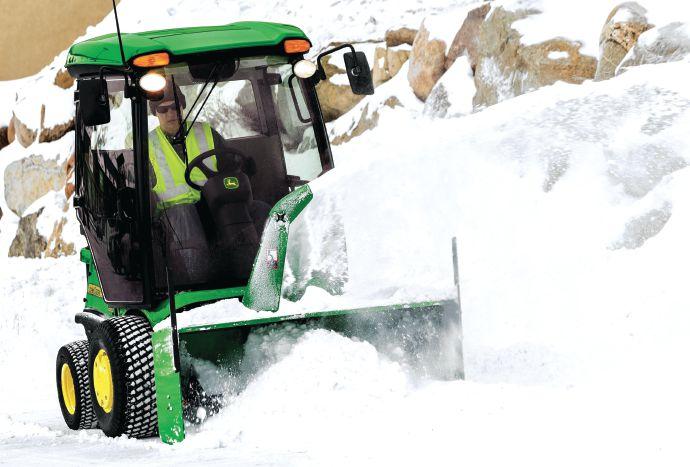
will be spotless and ready to go.
As we move into the fall and winter seasons, this provides a great opportunity to revamp your equipment, whether through routine maintenance, or major repairs that will lead to machine downtime. It is important to refer to the owner’s manual to ensure that you are completing the necessary maintenance to keep your machine up and running.
Routine maintenance, like an oil change, is good to perform at this time, ensuring that your machine will be ready to go once spring arrives. Also, give tires a once-over. Winter weather can affect tire pressure, particularly if machines have been stored for months. Check the tire pressure and examine treads for wear.
The mower deck and blade are the most important parts of your mower. During the fall and winter season, take the opportunity to inspect and replace any excessively worn belts, or make repairs to the deck
shell. A busy mowing season can take a toll on a mower deck and blade, so it is a good idea to pay extra attention to those parts in the off-season.
Check blades for dullness and corrosion. If the blade is dull, sharpen it to ensure a quality cut. Replace any blades that have logged too many hours. It is also important to check blade balance for an even cut.
Wash before storing
As mentioned above, you should wash your equipment, especially prior to storing it for an extended period, by using pressurized air where possible. However, if water is necessary, a low pressure and low flow water is recommended to protect electronics. Make sure to lubricate and cover grease fittings, per your owner’s manual. You want use manufacturer-recommended lubricants, as they were designed to perform to the manufacturer’s specification. Additionally, be sure to add fuel
A front mower is also ideal for winter work, including plowing and blowing.
FUTURE BUSINESS GROWS IN SILENCE




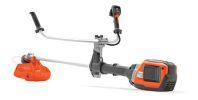





Today’s green spaces need modern care. Husqvarna’s lightweight, powerful and durable battery tools are long-lasting, quick to change and have zero direct emissions without compromising on performance. They are also much quieter than their gas equivalents so you can start earlier, finish later and get more work done – without disturbing the surroundings. More and more professionals are switching to Husqvarna so they can grab a piece of the action. Visit Husqvarna.us/demo to sign up for a free demo and you’ll see what we mean.
Landscaping
stabilizers. A fuel stabilizer prevents separation that can lead to corrosion. Simply run the engine for five minutes to ensure the stabilizer is distributed throughout the fuel system. It is always a best practice to change the oil right before storage or before your first start up. Also check coolant if your equipment is liquid cooled. Finally, remove the battery, clean up its terminals, and charge it in the off-season.
Proper service is key to keep the machine running smoothly. While you may believe that you will remember the work you performed in December, by the time March arrives, you probably will have forgotten. Track maintenance in a logbook, which will give you something to refer to in the spring.
The off-season is the perfect time to examine your fleet, as well as your business, and evaluate what you may need for the next season. The first step is to audit your equipment and note any aged equipment that may need to be replaced. Connect with your dealer, who can help not only determine what equipment you need, but also guide you through the purchasing process. If you do need to purchase equipment, meet with your dealer to prepare a quote, and consider all payment options, including upfront cash, financing offers, and leasing offers.

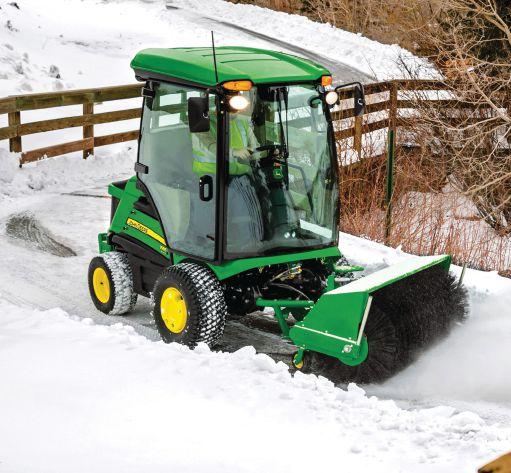
Parts management is vital to limiting machine downtime. Take some time this off-season to revamp your parts department, which will improve your profitability once the mowing season starts up again. First, assign inventory ownership, limiting the number of employees with access to parts storage. With one person overseeing the parts department, it ensures efficient management of the inventory.
Stay organized
Organize and label bin locations, creating a designated, labeled part storage location so that the manager is aware of where things are and what needs restocking. Include a minimum stocking level on the label so the manager knows when things need to be reordered.
Finally, create an immediate tracking process and schedule regular inventory reviews. It may be tempting to wait until the end of the day to track parts that were used, but that increases the chances that a part will be used without notice. Establish an immediate tracking mechanism to limit the risk of forgetting a part through work orders or spreadsheets. Then, on a periodic basis, review the parts inventory, using the time to examine what is being used and adjust minimum levels accordingly.
Add or remove parts that are needed or not needed anymore. If new machines join the fleet, professional landscape contractors need to make sure that they have the right parts. As fleets grow, so does the need for parts. By revamping your business now, you can avoid unnecessary setbacks come spring.
Prepping for cooler weather starts with selecting the right equipment. There are so many options in the market, and choosing the right machine for the application can often feel overwhelming. Fortunately, an equipment dealer is a great resource to help identify the right machine for the job. A dealer will be
Brooms help keep surfaces clear during the heaviest of winter storms.

able to walk through the options, discussing property size and type, the type of jobs you would like to complete, as well as any other special needs, including horsepower.
Equipment for winter needs
There are three primary machines that are used to maintain land during the winter: utility vehicles, front mowers, and compact utility tractors. While all three machines have benefits and features that make each ideal for winter maintenance, each machine can also be used for jobs in warmer months as well.
Utility vehicles can be a great solution for maintenance during the winter months due to the versatility of the machine. From transporting handheld equipment, materials, such as salt, and crew members, to using attachments to prep the grounds before a winter storm, utility vehicles are great for winter maintenance. The ability to customize utility vehicles with a heated cab is ideal for winter, as it keeps workers comfortable and productive, even in below freezing temperatures.
Additionally, utility vehicles are designed to be compatible with a wide variety
of attachments. For example, blade attachments can make snow plowing more manageable, while bed sprayers can also double as a de-icing mechanism.
A machine often associated with warm weather jobs is the front mower. While the name may be deceiving, front mowers are ideal for winter work, including snow blowing and plowing. Implements such as snow blowers can attach to front mowers and clear even the most difficult-to-remove snow.
Those located in areas with less snowfall should consider using a rotary broom or blade to remove lighter amounts of snow much more efficiently. Most front mowers have a cab option which further enhances the appeal for users during the cold months.
Another machine that groundskeepers should consider for winter work is a compact utility tractor. Commonly associated with mowing and digging, compact utility tractors can handle a wide variety of tasks through the use of implements.
In winter months, blades, blowers, snow pushers, and brooms help keep grounds clear during the heaviest of snow. Also available with a heated cab, compact utility tractors allow operators to stay productive in all conditions. Additionally, the ability to use other implements, including mowers, loaders, and backhoes, make compact utility tractors a great solution for maintenance throughout the year.
With fall here and winter fast approaching, it’s imperative to make sure equipment is properly prepared for the frigid temperatures. Always maximize the use of attachments and implements, make sure equipment is properly serviced and in good standing, and properly store machines if equipment won’t be used during the winter months.
Nick Minas is go-to-market manager at John Deere.

A plow blade is attached to a front mower.
Mechanical drills’ end-of-year care
Tips to ensure a simple transition from winter storage to
spring usage
By Mike Hale
As the end of the busy season wraps up, it’s time to take a closer look at your mechanical earth drill. When it comes to a smooth drilling operation, it’s a matter of a well-operating machine.
Yes, choosing a top-performing, reputable drill manufacturer plays a huge role in the success of your drill, but performing routine and end-of-season maintenance is important to prolong the life of your equipment, and ensuring it performs when you really need it.
Routine drill maintenance includes examining, cleaning and lubricating key drill components roughly every 30 days or 40 hours of operation. But what happens at the end of busy season, when your drill makes its way to storage for a few months?
Whether you’re an owner or a rental centre, there are a few steps you can take to ensure a simple transition from storage to usage in the spring.
Inspect the drill
After every use of your earth drill, take a look at all of the components to ensure everything is in working order. End-ofseason maintenance includes taking that inspection one step further. Make sure the blades are past the flighting. When the blades start to wear flush with the auger, it’s time to flip the blades or replace them. If the blades wear to the auger flighting and wear the actual flighting, operators
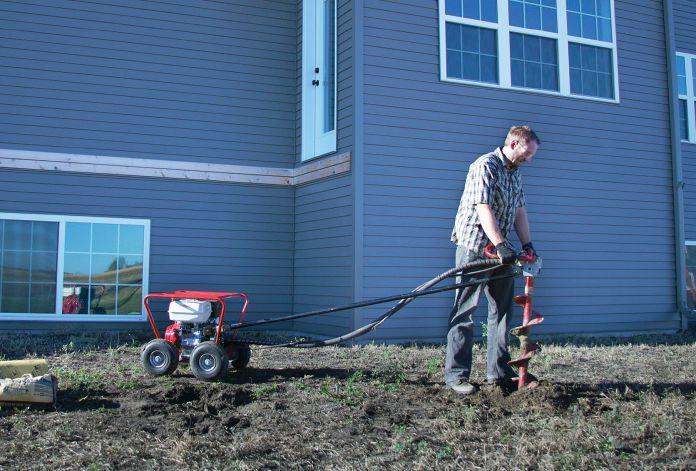
will either need to repair the auger flighting or replace the entire auger.
Take a few more steps to complete the detailed inspection. Ensure all bolts are tight, and make sure all carbide blades (used for hard clay, frozen ground, or hardpan soils) are sharp. If the carbide blades feel worn and rounded, sharpen them with a bench grinder. Using a silicone carbide bench grinding wheel, hold the blade at a five-to-seven-degree relief angle to sharpen it.
The push-button connector should be in good shape, with no visible rust. Check the throttle lever for damage or wear. Inspect the throttle cable, too. When you pull the lever, the cable should move freely on the other end. If it sticks, replace it. Some users might be able to remove the cable, clean it and reattach, but, if the cable is frayed at all, it will be difficult to get back in. Replacing is often the best option.
Inspecting your drill’s flex shaft should be done two or three times a year, but is especially important during end-of-year maintenance. There shouldn’t be any cracks or wires on the outer housing. If it’s in good shape, simply remove the core, clean it, re-lube it and slide it back in. If the flex shaft shows signs of cracks or wires, it should be replaced.
If any parts are in need of replacement, contact the manufacturer. Addressing replacement parts prior to storage is a better alternative to waiting until spring. Store your drill with peace of mind, knowing it’ll be ready to operate in the spring, rather than dealing with potential delays waiting for parts.
Replace fluids and filters
Transmission fluid should be replaced regularly. If your fluid has a lot of metal shavings in it, that can be an indication of excessive gear wear or missing teeth. If
After every use of your earth drill, take a look at all of the components to ensure everything is in working order.
Snowstorms can’t stop you. Because 4R Tractors have great snow removal options, including a rear mounted snow blower, an optional cab with heat and ac, work lights, and a front loader to help clear the way. Be snow ready. Be clear. Get the power of 4. JohnDeere.ca/4Series
RUN WITH US. Nothing Runs Like a Deere™ Search “John Deere 4 Series” for more
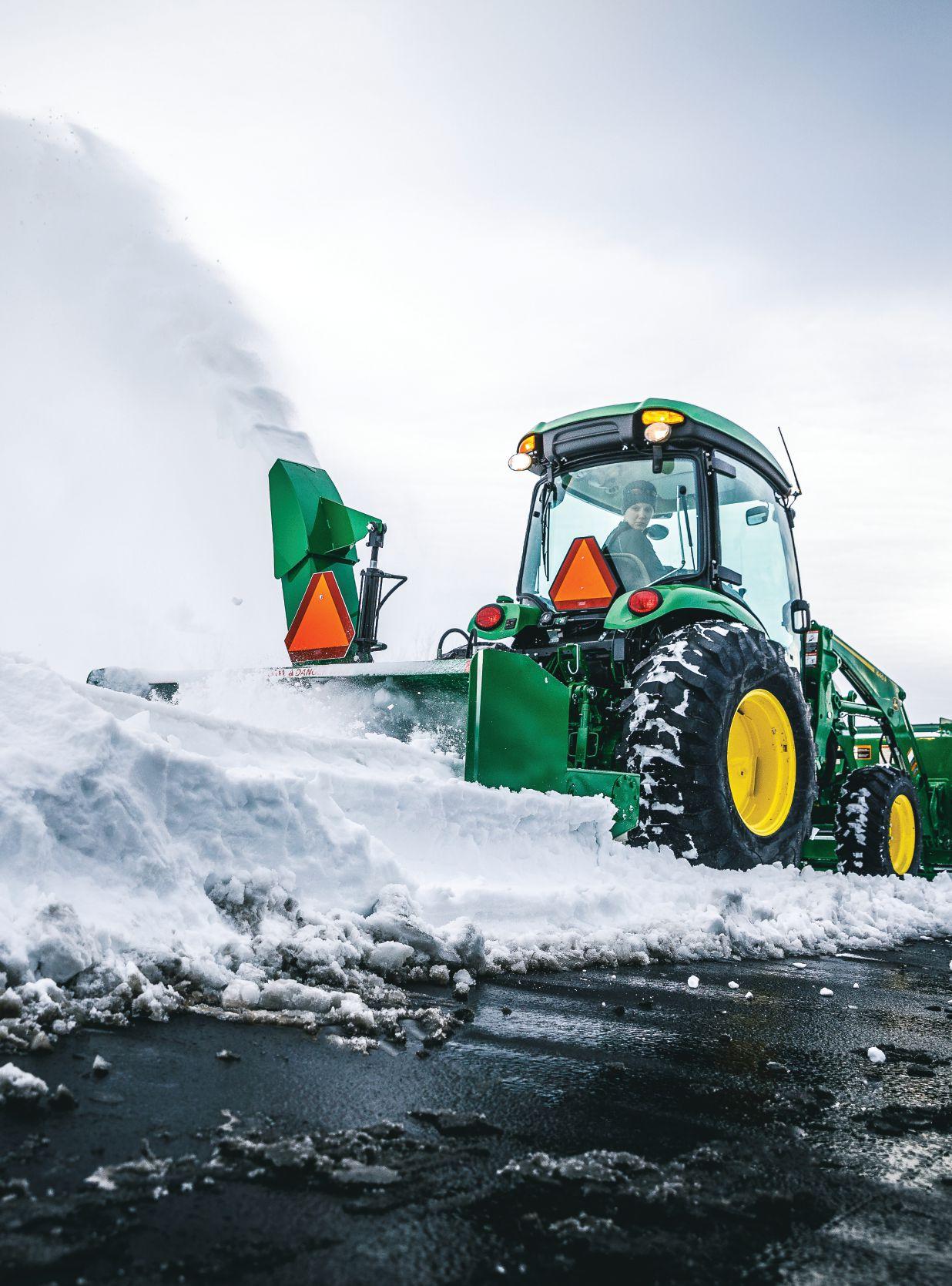

Shown with optional features. John Deere, the leaping deer symbol and John Deere’s green and yellow trade dress are the trademarks of Deere and Company.

Little Beaver’s Hale was company’s marketing manager
Turf & Rec is saddened to learn of the sudden Sept. 4 passing of Mike Hale, long-time sales and marketing manager at Little Beaver Inc. and the author of the accompanying article.
Mr. Hale had written several educational articles over the years for Turf & Rec, on the subject of earth drills and augers. He began working in fencing as a summer job while in high school. After learning the industry as a teenager, he continued installing fences across southern California, eventually owning his own fencing company for more than 20 years.
“Performing end-of-season maintenance is important to prolong the life of your equipment.”
the fluid is changed regularly, you won’t experience gear wear. If you hold the output shaft and wiggle it, you shouldn’t feel a lot of movement.
Motor oil and filters should be cleaned and changed. Clean filters with an air hose, or if they’re foam filters they can be shaken out.
Clean and prep for storage
Considering the job, it’s natural that earth drills get dirty. Dirt and clay adhere to the blades of the auger, which can diminish the efficiency and performance of the equipment. Not only should your machine be wiped down after every use, it should also undergo a deep cleaning during end-of-year maintenance.
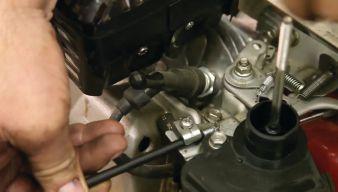
eventually rust if left outside or in places with a lot of moisture, such as propped up outside against a building.
Mr. Hale joined the Little Beaver company in 1996, and had been the voice behind sales and quote inquiries for the past 25 years.
Project2:Layout 1 8/21/14 10:08 AM Page 1
“Mike’s impact on our company and industry has been tremendous,” Little Beaver president Joe Haynes said. “He understood the challenges our customers faced and was really able to help them find the solutions they needed. He will be greatly missed by all of us at Little Beaver, not only for the work he did but also for the person he was. We have lost a dear friend and industry advocate.”
Are you prepared for the season?
Remove all debris from the earth blades using warm, soapy water. Avoid using a power washer, as the pressure can damage the equipment.
To prep for storage, disassemble the drill and remove the torque tube and auger. Drain the fuel or add fuel neutralizer before storage.
Always store the drills upright in a dry place because the steel components will
Keep in mind the importance of end-ofyear maintenance and the role it plays in the overall lifespan of the drill. Cleaning and storing the machine properly contributes to the continued success of your drilling operation
Mike Hale is former sales and marketing manager at Little Beaver, a manufacturer of drilling equipment for three generations. The company serves the needs of end users, from professional contractors to rental centres, with such accessories as augers, extensions, points and blades. For more information, visit www.littlebeaver.com

Throttle maintenance.

Ford looks for Lightning strike with electric F-150
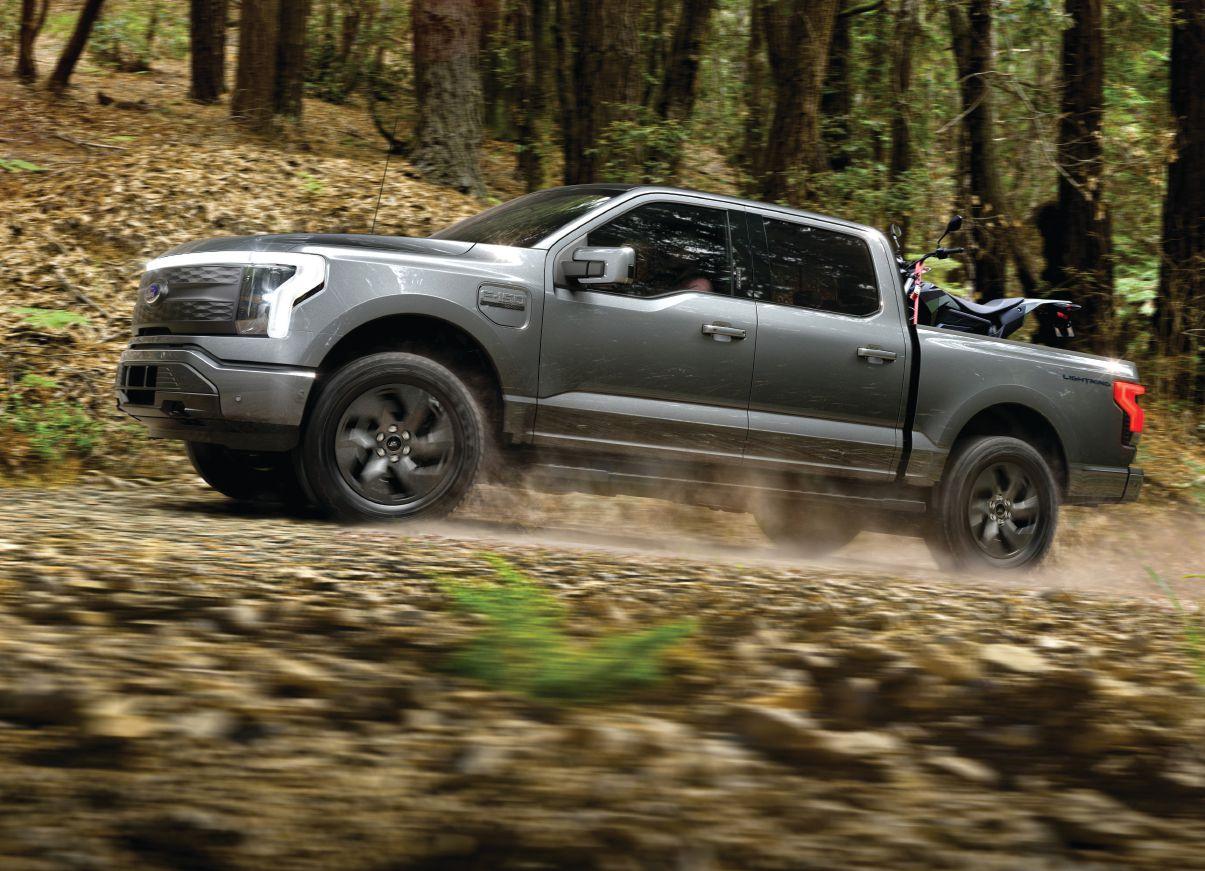
Electric vehicles are nothing new and have been around much longer than many people realize.
By Mario Cywinski
Uptake on electric vehicles is growing, however, the slice of the pie for EVs is still very small. Factors such as range, charging infrastructure and, most importantly, type of vehicle have been the main reasons for customer hesitancy. The majority of EVs until recently were hatchback-style vehicles, which many customers enjoy, but they are not the crossover/SUV style vehicles that are growing exponentially, or the best-selling segment of the vehicle market –pickup trucks.
Now, it is one thing for Tesla, which has built its entire brand on EVs, to announce the Cybertruck pickup or for niche EV companies to do the same, it is quite another for the segment leader to
announce that it is entering the ring with an electric-powered pickup truck.
For many years, the Ford F-Series has been the top selling vehicle in both Canada and the United States. Ford has put many innovations into the F-Series, most recently with a hybrid version of its F-150 (as the PowerBoost), and before that with the introduction of an aluminum body.
It’s next innovation is trying to take electric power mainstream by introducing the Ford F-150 Lightning. The fully electric F-150 gives pickup truck customers an option for an EV, within the largest segment in the industry.
“For both Ford and the American auto industry, F-150 Lightning represents a defining moment as we progress toward a zero-emissions, digitally connected
future,” Bill Ford, executive chair, Ford Motor Company, said. “F-Series is America’s best-selling truck for 44 years, the backbone of work across the country, and a trusted icon for generations of customers. Now we are revolutionizing it for a new generation.”
Lightning offers two lithium-ion battery options, a standard range version with an estimated 370 kilometres of range, and an extended range version with an estimated 483 kilometres of range. Both versions show that “range anxiety” is a thing of the past for EVs. Going further, the standard range model offers 426 horsepower, while extended range model has 563 horsepower on tap. Both offer 775 foot-pounds of torque. The extended range model has an estimated 0-60 time in the mid-four seconds range.
The 2022 Ford Lightning F-150
Projected charging times with a Level 3 charger (50 kW/150 kW) for 15 per cent to 85 per cent is (91/44) minutes for a standard range, and (122/41) minutes for an extended range. While Level 2 charging on standard range can be 10-14 hours, and extended range eight to 19 hours, both depending on the charging station that is being used.
In terms of truck capability, the Lighting will offer estimated maximum payload of 1,800 (extended-range) to 2,000 (standard-range) pounds. Maximum estimated towing ranges (with max trailer tow package) from 7,700 pounds (standard-range) to 10,000 pounds (extended-range).
Four trim levels will be available for the Lightning, a fleet-focused work truck, Pro trim, along with XLT, Lariat and Platinum. The top range Platinum trim is only available with the extended-range battery, while the Pro trim is only available with the extended-range for fleets. The middle two trims are standard with the standard-range battery, with the option of having the extended-range version.
A new feature on the Lightning, that may be a selling feature for some, is Ford Intelligent Backup Power. What the feature does is basically turn your truck into a backup power source for your home. The system gives the Lightning the ability to offload 9.6 kW of power. When using the truck with an 80-amp Ford Charge Station Pro and a home management system, the system sends power to the house, instead of charging itself. Once power is restored, the truck goes back to charging its battery.
Ford says that an extended-range battery model can power a home for up to three days, when using an average of 30 kWh of daily use.
“Whether sheltering during a storm or trying to stay safe in a heat wave, customers can now use their truck to give themselves power when they need it most,” Ryan O’Gorman, electric vehicle manager, Strategic Partnerships, said. “F-150 Lightning is built for seamless transitions between charging your
vehicle and powering your house when needed – and Ford is the first in the North America to offer this capability on an electric truck.”
Another innovative feature of the Lightning is that as a result of not needing as much space up front for an engine and transmission, the under-the-hood section of the vehicle is now a trunk. It offers 400 litres of volume and 400 pounds of payload, has four electrical outlets, two USB chargers and a drainable floor.
The Ford F-150 Lightning is expected to arrive in Spring 2022.
“We’re not here to make an electric truck for the few,” Kumar Galhotra, Ford president, Americas and International Markets Group, Ford Motor Company, said. “Ford is committed to building one that solves real problems for real people. F-150 Lightning delivers everything
we’ve said electric vehicles can offer, plus the capability expected from a Built Ford Tough truck – not just near instant torque, but powerful towing and hauling customers can depend on.”
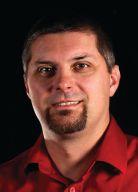
Mario Cywinski is the editor of Plant magazine, Machinery and Equipment MRO magazine and Food and Beverage magazine, a member of the Automobile Journalists Association of Canada, and a judge for Canadian Truck King Challenge. He has more than 13 years of editorial experience, nearly three years of maintenance, reliability, and operations experience, more than 16 years of automobile industry experience, as well as small business industry experience.
Introducing the NEW Hurricane


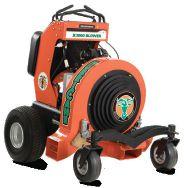


Boyd Montgomery and Matt Anderson are certified sports field managers with The Toro Company.
Make sports turf clean-up a priority this fall season
Give your turf a healthier head start in the spring
By Boyd Montgomery and Matt Anderson
Prepare the right way this fall to be rewarded with a more successful spring. With adequate cleanup, attention to detail, and proper equipment maintenance, your turf will have a healthier life come next year. The standard practices of debris management, fertilization, overseeding, and auditing irrigation systems will help the turf achieve the health and vitality it needs to thrive throughout the winter.
Manage debris
Before you fertilize, clear the turf of leaves and debris. If your fields are surrounded by mature trees, this can be a monumental task, but it’s necessary for turf health. Allowing the grass to breathe over the winter allows it to receive the proper nutrients, avoiding serious disease and discolouration.
There are multiple ways to make debris management quicker and easier. To start, turf managers can consider adding a debris blower and a sweeper to their fleet. A debris blower is an extremely versatile tool for fields that uses a turbine style blower to clear grass clippings and leaves. They have enough force to send wet, heavy leaves flying in the direction you want them to go. It even uses a wireless remote, giving the operator complete

control without needing to leave the tractor.
A sweeper/vacuum can also be a timesaving piece of equipment. If your fields tend to collect a lot of leaves and debris, a sweeper machine will pick it up and clear it out. Sweepers combine a powerful vacuum, precision pickup capabilities, and a large hopper to reduce trips back and forth for dumping.
Fertilize
Fertilizing in the fall is an easy way to restock your field turf’s reservoir of vital nutrients after a long, hot summer. The extra boost will both help turf survive the upcoming winter and give it a head start on growth next year. Make sure to use a fast-release style fertilizer that allows the turf to take up nutrients quickly before going dormant for the winter.
Turbine blowers will clear clippings and leaves from turf, allowing it to breathe over the winter.
“Taking extra preparation in the fall is crucial to keeping your fields in top condition.”
Overseed
Overseeding is a technique used to revive the thickness of plant growth in select areas – and fall is the ideal time to overseed. To get the most out of these efforts, turf managers should prepare and care for the turf beforehand, giving the new seed the best opportunity to thrive. Here’s how:
• Mow the grass. Mow the turf slightly shorter than usual and bag clippings to ensure the seeds have a clear path to reach the soil and receive enough sunlight to grow. Continue mowing
at this length on a regular basis throughout the fall season. Avoid cutting more than one-third of the grass at a time, since fall season grass is more susceptible to injury.
• Remove thatch buildup. Raking up thatch is recommended for the same reasons as mowing shorter and bagging the clippings are – to allow the seeds room to reach the soil. Use a rake to dethatch manually, or a power rake for an extra boost.
• Aerate the soil. Aerating in the fall is
not only an essential step, but one of the most important actions turf managers can do to maintain their fields’ health and playability. Aerating loosens the soil and gives the seeds the best chance to take root.
• Address soil nutrition. The most important factor in seeding success is seed-to-soil contact, but a close second is soil nutrition. Fall is a good time to get the soil tested for nutrient deficiencies to ensure seeding success. Turf managers can reach out to their local extension office for assistance and resources on soil testing.
Audit irrigation systems
Make it a yearly habit to audit your irrigation systems for leaks, sprinkler head




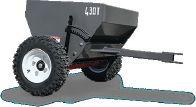
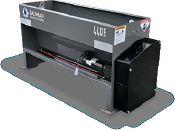



Sports turf
cracks, and unusual puddling. If repairs are needed, the fall season is an excellent opportunity to cross them off the list. Once the irrigation systems are audited and repaired, the systems should be winterized.
Winterizing irrigations systems involves blowing out the pipes to remove any water, turning off the water source, and checking for damage to the electrical components. Skipping this step could lead to pipes freezing, bursting and leaving you with much larger problems. Being proactive in the fall will both protect the integrity of the irrigation system once it is started up again.
Maintain equipment
Spring and summer are tough on equipment, but that’s what makes fall maintenance so crucial. Set your machines up for success in the spring by following preventative maintenance and servicing standards throughout the fall and winter.
Maintenance should include changing fluids, replacing worn hydraulic hoses, replacing mower blades, checking and cleaning air filters, sharpening or re -

placing reels, and cleaning and rebuilding painter pumps.
Keep a record of service dates and maintenance schedules for your own reference in the future.
Store equipment
How you store equipment is dependent on where it’s being stored – either in a


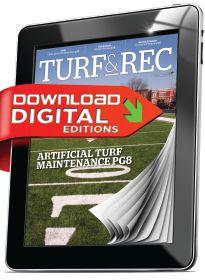
controlled environment or an environment with colder temperatures. If machines are stored in a heated building, no extra precautions are necessary. If equipment is going to be stored in a cold environment, on the other hand, turf managers should use a fuel stabilizer and consider using engine heating blankets to protect the engine.





Mini excavators lower cost, increase efficiency
Caterpillar’s new 302.7 CR, 303 CR and 303.5 CR hydraulic mini excavators, built on the Next Generation platform, offer consistent operator experience through the 1.5 to 10-tonne range. Boosting operating efficiency, servicing ease and operator comfort, each new model features exclusive stick steer, cruise control, operator-adjustable settings and a tilt-up canopy or cab as standard features.
Expanded use of common parts throughout the line plus their damage-resistant exterior construction help to reduce parts inventory investment and lower repair costs. Daily maintenance checks are quickly made from ground level through side doors, while the tilt-up cab design offers ccess to

components for servicing. Increased service intervals mean these excavators spend more time on the job and less time in the workshop. Combined, these features lower total ownership costs up to five per cent, compared to previous models.
At the same time, design enhancements for the new 302.7 CR, 303 CR and 303.5 CR
deliver up to 10 per cent more performance in travel and trenching. Hydraulic system upgrades improve lifting performance and cycle times, while customizable operator settings improve efficiency.
The turbocharged Cat C1.1 Turbo engine powers the 302.7 CR and 303 CR models, while the Cat C1.7 anchors the powertrain for the 303.5 CR. Both engines meet U.S. EPA Tier 4 Final emissions standards and offer 23.6 hp (17.6 kW) net power. Standard auto idle and auto engine shutdown help to conserve fuel usage at the site for more affordable operation.
These Next Generation mini hydraulic excavators feature a compact radius swing that reduces overhang when working to the side, allowing the machines to optimize performance in confined spaces.
For more information, visit www.cat.com

THE TURF PROBLEM SOLVER
Proven solutions to nagging turf problems
The Turf Problem Solver is a solutions-oriented guidebook designed to help turf managers maintain optimal turf conditions. Written by two leading experts, this practical tool offers detailed advice on defining, analyzing, and solving today’s most common turf problems.
Presented in a distinguished case-based approach, The Turf Problem Solver features:
• Real-world examples and solutions
• Solutions for environmental, cultural, and pest and pesticide turf problems
• Coverage of human resources issues
• Accessible methods for evaluation, analysis, and synthesis
• Helpful appendices providing chemical names, maps, conversion charts, and calibration guidelines
$99.00 Item #0471736196

Health & Safety
By CCOHS
How fall fatigue impacts outdoor workers

Cold, dark mornings, fleeting afternoons, and early sunsets are signs of autumn. And as days get shorter and cooler, workers in every setting often report symptoms of fatigue, such as feeling a little foggy, being mentally or physically tired at work, and struggling with motivation. For outdoor workers, these symptoms can be even more obvious – and potentially more dangerous. To keep workers safe, employers need to proactively address the risks of worker fatigue.
Workers may think that feeling tired, run down, or sleepy are simply signs of the season, but any number of work-related factors may be causing the fatigue they are experiencing. Fatigue is a workplace hazard that employers in turf and grounds maintenance should be proactively addressing year-round.
The impacts of fatigue can be considered a form of im-
pairment, making it a workplace hazard that can be dangerous for not only the worker, but other employees and even members of the public. In landscaping, for example, if preventative measures aren’t put in place, long hours of physical exertion or extended workdays may result in incidents while operating loaders or heavy equipment. A fatigued worker may also be susceptible to collisions while driving other crew members to and from the worksite.
Research has shown the number of hours spent awake can have a similar impairment effect to blood alcohol levels. One study reports that 17 hours awake is equivalent to a blood alcohol content of 0.05, and 21 hours awake is equivalent to a blood alcohol content of 0.08 (the legal limit in Canada). Other studies show that workers who sleep for less than five hours before work, or stay awake for more than 16 hours, have a significantly
‘The number of hours awake can have a similar impairment effect to blood alcohol levels.’
higher chance of a fatigue-related incident at work. While it can be difficult to isolate the effect of fatigue on incident and injury rate, understanding it as a workplace hazard and implementing controls can help employers prevent fatigue-related incidents.
Helping outdoor workers fight fatigue
Fatigue can be addressed through your safety management system, or as a separate fatigue management program that includes a number of actions.
Train supervisors and workers to assess the risks by taking a thorough look at each project or job site and identify equipment, situations, and processes that have an increased risk of causing harm due to fatigue.
Once fatigue hazards have been identified, they can evaluate the risk level and decide how to eliminate or control the harm.
On darker days, workers may need artificial light sources and reflective gear to see properly and be seen and to work safely. They may become more fatigued when they are doing repetitive, time-consuming or laborious tasks, so it’s important to change things up and offer variety in their work throughout the workday.
Are your crew members working in shifts? Where you can, optimize the design of the shift schedule by establishing the length of the rotation period and direction of the shift rotation. For example, it’s best to create a schedule for shift workers that rotates forward. Going from a day shift to afternoon/evening shift, and then into night shift, is easier on the body and helps build a routine. If you can, make adjustments. The most demanding and highrisk tasks should be avoided towards the end of shift, or between certain hours (e.g., between the hours of midnight and 6 a.m.) when employees may be less alert.
Most people require at least seven to nine hours of sleep each night. Educate workers on the importance of getting a good sleep and encourage them to stay home if they’re suffering from sleep deprivation. What helps one person sleep may not work for another, but general tips include going to bed and getting up at the same time every day, limiting screen time before sleep, and exercising regularly.


Take the extraordinary snow removal capabilities of Bobcat ® equipment into small lots, sidewalks, driveways and other places where a maneuverable machine is a must. Plus, stay comfortable in cold weather with an optional enclosed, heated cab. Small articulated loaders are available now at your local Bobcat dealer.

ECHO’S GOT YOU COVERED!
INDUSTRY LEADING WARRANTIES PROFESSIONAL DEALER SUPPORT ENSURES SUPERIOR PERFORMANCE.
UNBEATABLE FLEET PROGRAM SAVE UP TO 20% ON QUALIFYING PURCHASES WHEN YOU INVEST IN ECHO.*
POWER, PERFORMANCE & PRODUCTIVITY
INNOVATIVE X-SERIES “PRO-FOCUSED” PRODUCTS DELIVER DAY IN & DAY OUT!
A TOOL FOR EVERY JOB FROM ARBORISTS TO LANDSCAPERS — ECHO HAS THE TOOLS TO GET THE JOB DONE RIGHT!
